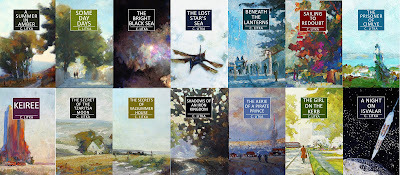C. Litka's Blog, page 24
February 24, 2024
The Saturday Morning Post (No.36)

This week we have a book that my sister-in-law gave to my wife. Since she wasn't going to get around to reading it just yet, I decided to give it a try.
My reviewer criteria. I like light, entertaining novels. I like smaller scale stories rather than epics. I like character focused novels featuring pleasant characters, with a minimum number of unpleasant ones. I greatly value clever and witty writing. I like first person, or close third person narratives. I dislike a lot of "head jumping" between POVs and flashbacks. I want a story, not a puzzle. While I am not opposed to violence, I dislike gore for the sake of gore. I find long and elaborate fight, action, and battle sequences tedious. Plot holes and things that happen for the convenience of the author annoy me. And I fear I'm a born critic in that I don't mind pointing out what I don't like in a story. However, I lay no claim to be the final arbitrator of style and taste, you need to decide for yourself what you like or dislike in a book.
Your opinions are always welcome. Comment below.
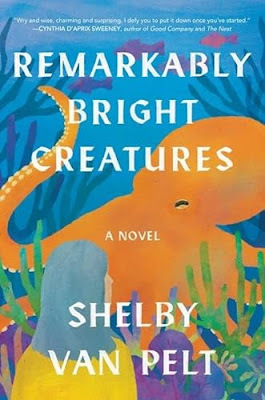
Remarkably Bright Creatures by Shelby Van Pelt DNF 12%
This is almost certainly the case where I'm not the author nor the publisher's target audience, so that when I say that I utterly failed to connect with the story, it should come as no surprise. I thought that after enjoying Lessons in Chemistry, I might find another rather female reader orientated book enjoyable. But this one, well... 45 pages into it she was still introducing her cast of characters, one of which is an octopus, without a discernable plot. I decided to bail.
The beginning of this novel reads very much like some of those cozy mysteries I tried last year; a recital of everyday events and lots of people. The main point of view character - but not the only one - is Tova, a widow whose 18 year old son mysteriously disappeared 30 years before. The blurb on the cover flap says that Marcellus, an octopus, becomes a friend of Tova and helps her solve the mystery of her son's disappearance. So it's a cozy mystery? Reads like one. But...
Now I'm a fan of leisurely paced books. I actively dislike slam-bang openings, so I shouldn't be complaining about the opening. But, there is slow, and then there is slow and cluttered, and this opening is so very cluttered. Not only did almost all of characters we're introduced to seem to be minor ones, but all the everyday incidents that are intermingled with a collection of seemingly unimportant background stories buried the narrative line of the story, at least for me, with trivia. Except for one random scene with a seemingly minor character who is apparently unconnected to Tova. This character is a guy who doesn't know who is father was/is. Given the blub on the cover... it struck me as suspicious; for once there seemed to be rather obvious reason for his inclusion, but of course I could be wrong, not having read the book. Just say'n;)
The most significant character after Tova is the octopus, Marcellus, who has his own first person narration chapters. After a dog as a character in Lessons in Chemistry, I thought this might be interesting. I was wrong. I found the octopus to be far too human to be even remotely believable as an octopus. Somehow I was supposed to believe that this octopus had learned to read and understand spoken English, while living underwater in an aquarium tank. Not only did I find that I could not suspend my disbelief that this was even remotely impossible, but it seems to me that if you're going to have a first person octopus in your story, you should come up with a clever way to make the octopus seem more than just a human in a fish tank. The octopus needs to be at least a little bit alien in its thought process. Not so here. Other than describing its actions as an octopus in an tank, it just think and sounds like a human.
Add to this the fact that since I read to escape the everyday life of the world around me, I really don't care for stories set in contemporary times. This book only reinforced my disinclination to read anything set in our time and/or place.
This is, however, a best selling debut novel, so obviously, once again, it's me, not the book. Next up, two very long books from the library. We'll see how they fare.
February 21, 2024
The Apple Audiobook Saga

You know, I didn't believe them when Draft2Digital said that it could take up to two months to produce an audiobook for Apple, since Google could deliver an editable version of one in two hours. But I was wrong. It looks like it can, and will, take two months, or more, to spit out the audiobook versions of all my novels. I signed on to Apple Audio books via Draft2Digital on the first of January 2024. The Secret of the Tzaritsa Moon appeared on the 18th of January, two more appeared on the 8th of February, two more 16th of February, and here we are, on the 21st of February and they are still not all out. So, yeah, they weren't just under promising.
Beggars can't be choosers, so I'm not exactly complaining. I'm just noting the glaring differences between the two companies, in terms of products delivered.
There are many other differences as well. Let's start with Google.
First, you have to upload your own homemade ePub file to Google. And once they have your ebook, you can then select the audiobook option. Within a couple of hours you have the text, or more correctly, the audiobook script, available to you prior to release which you can edit before releasing it.
Google offers about a dozen different English narrators in both male and female voices to choose from; two each with different English accents, including American, British, Australian, and Indian. You can also alter the narrators speed to further customize the voices.
You can review the text, and highlight words to hear how the AI pronounces them, which is very handy in the case of invented words; names, places, etc., and you can alter the spelling in the audiobook script to get these words to sound the way that you envisioned them. You can also insert pauses where you think they're needed, but not inserted automatically.
You can also choose to assign different voices to different characters, though you would have to go through the script highlighting each instance of that character's dialog, perhaps a hour or two's worth of work. If the character's voice is distinctive enough, you might also be able to eliminate dialog tags ("he/she said.") as you go. You get distinctive voices rather than one narrator "doing voices," which honestly, I find sort of annoying, though I've not heard the popular voice actors doing it, so it might be better than the small sample I've listened to. I haven't taken advantage of this feature because I picture the story being told by a single narrator. However, from some of the samples of my stories I've listened to, I can see the advantage of this feature, since without the visual clues of the text, it can be unclear who's doing the talking. But if you do one character, would you need to do all the major ones as well? A slippery slope...
When you're happy with how things sound, you just select a price, and hit "publish." It will take a few hours for it to be live. You can go back and edit it, whenever you like.
Turning to Apple, you do Apple's auto-generated audiobooks through Draft2Digital's page for the book you want to offer as an audiobook. Click on the audiobook option, and then on the Apple option.
After that, the audiobook is produced from the ebook version published by D2D. All you have to do is select the genre you want to offer the book in and its price. Apple offers only two male and two female voice, and they select which one will be used based on your book's genre. Click publish and wait. You can not modify the audiobook text for free after that, and have to keep it up for at least six months. It's very simple, but you have very limited options.
Both services require a square cover; Google a 1Kx1K pixel one, Apple a2Kx2K one, though D2D will create one for you from your ebook cover. I used my own.
So what do they sound like? The first link is to the sample page for The Mysteries of Valsummer House on Apple Books. Hit Listen. The second is that book's audiobook page on Google, once again just hit play, though it starts at the beginning instead of a minute or two into the text like the Apple sample.
I'm not sure what voice Apple used.
The Google voice is "Archie," a British English voice.
Whose AI do you think does a better job at creating a human narrator? And if you're a regular audiobook reader, how far from human narration are these books?
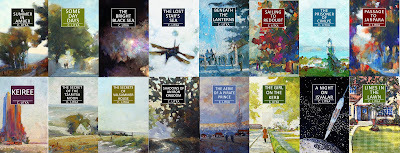
February 17, 2024
The Saturday Morning Post (No..35)

I suspect that this will be the first of many reviews coming in 2024 of Ellis Peters' Cadfael mysteries. As I mentioned previously, I picked up all seven 3 book omnibus versions of these stories - 16 novels and a number of short stories, that I will hopefully be reading at a nice sedate pace. The problem will be finding something better to read.
In any event, two more novels, this time from the Second Cadfael Omnibus.
My reviewer criteria. I like light, entertaining novels. I like smaller scale stories rather than epics. I like character focused novels featuring pleasant characters, with a minimum number of unpleasant ones. I greatly value clever and witty writing. I like first person, or close third person narratives. I dislike a lot of "head jumping" between POVs and flashbacks. I want a story, not a puzzle. While I am not opposed to violence, I dislike gore for the sake of gore. I find long and elaborate fight, action, and battle sequences tedious. Plot holes and things that happen for the convenience of the author annoy me. And I fear I'm a born critic in that I don't mind pointing out what I don't like in a story. However, I lay no claim to be the final arbitrator of style and taste, you need to decide for yourself what you like or dislike in a book.
Your opinions are always welcome. Comment below.
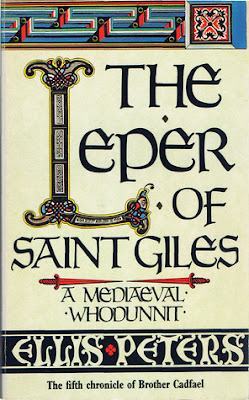
The Leper of Saint Giles by Ellis Peters A
In this story we have a young lady of 18, an heir to a large English estate, being forced to marry a 60 year old nobleman, as a business deal arranged by the young women's guardians. The wedding is to take place at the Abbey of St Peter and Paul. The young lady is in love with a squire of her future husband, and he is in love with her. When this is suspected, the squire is framed for theft, and when the bridegroom doesn't show up for the wedding, for murder. Along the way we have a mysterious Leper currently residing in the leper house of St Giles, as well as the usual crew of unlikely suspects... As always, an entertaining mix of murder mystery with a monastery and medieval backdrop.
In all these stories, Cadfael is the monk who is out and about because he has a far wider experience in the world, having spent his first 40 as a soldier and a sailor during the Crusades and is trusted to look into the worldly matters. Thus h's the one to examine the bodies, and investigate the circumstances surround them. And he's always to determine truth of the events, based on his wide experiences. That said, a lot of the story goes on around him as well, so it isn't all Cadfael all the time. This usually makes the stories more interesting, as each one features new, and often young, people in trouble. Still, as you will find in the review below, it doesn't always work.
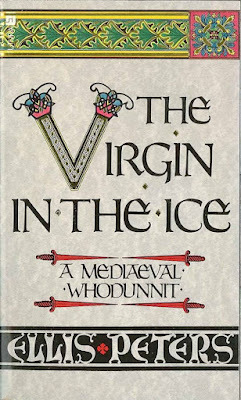
The Virgin in the Ice by Ellis Peters B-
My least favorite entry in the series, so far. I think because it was rather unfocused and too sprawling. Plus there seemed a lot of coincidences needed to tie everything together in a pretty bow.
The basic premise is that the sacking of Worchester during the ongoing civil war in England, resulted in a lot of refugees. These refugees including two orphans; an 18 year old girl and her 13 year old brother, along with a nun, who were bound for the monastery of St Peter & St Paul, but never arrived. A search is made for them. In the meanwhile Cadfael is called to a neighboring monastery to doctor a monk found naked in the snow. This mook seems to have some contact with the missing children and nun, which leads Cadfael out into the winter woods where he finds a woman frozen in a creek - the murder to be solved in this murder mystery. But there are the children to be found and lost again as well, plus, a band of bandit raiders to be located and dealt, plus there's the square of the King's enemy, Empress Maud, who has been sent by the children's uncle to find his niece and nephew who Cadfael must be consider a as well. As I said, sprawling and somewhat disjointed, more of a mediaeval adventure story than a mystery.
Worth reading as it gives Cadfael a little more background, but not quite up to Ellis' high standards for this series.
February 14, 2024
Introducing Passage to Jarpara
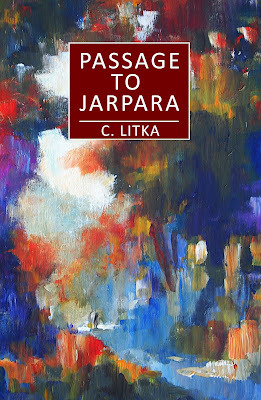
The first draft of Passage to Jarpara, my 2024 novel is completed, and I'm hard at work on the second draft. I'll announce a solid release date when I'm confident I can make it, but I can pretty much promise that it will be released before the end of May 2024.
From a business point of view writing, Passage to Jarpara was a terrible choice. It's a well known fact that every book in a series sells fewer copies than the book that proceeded it. And with only some 3,400 copies of the previous book in the series, The Prisoner of Cimlye sold, I'll be lucky to sell 500 copies of the book in 2024. Now, compare that likely sales number to that of my 2023 stand alone novel The Girl on the Kerb with sales of almost 6,000 copies in its first year, you can see the clear advantage of stand alone books. Of course I need to point out that I was very lucky to have Amazon somehow promoting The Girl on the Kerb, out of the gate. It was an exception to the rule for my books. Still, nearly a thousand copies of a new release in its first year used to be a more typical result. Seeing that it gets ever harder to sell books out of the mainstream, 500 books may be optimistic. Nevertheless those 6,000 copies serve to illustrate the potential up side of a stand alone book, one that is not tied to the sales figures of the previous books in a series - unless, of course, that series is a bestseller.
In view of all this, why in the heck is this my 2024 novel, you ask? Simply because it's a story I wanted to write. I wanted to wrap up the series with Taef Lang landing his dream a job, and that's what this story is all about.
There was, however, one other important factor going for it, namely that I had actually started writing this story back in the fall of 2022, and with a few weeks' work put in on it in January of 2023, I started in on it again in earnest, beginning on the first of October 2023, with 45,000 words already written. Which is to say, potentially more than half of the book written. I'd stopped writing it because I needed to come up with some 30,000 to 40,000 words worth of scenes, incidents, and stuff to do to fill out the middle of the story, for which I had no clue. Still, 45K words was too large of a story fragment to leave undone, so this fall I decided to push ahead and trust that push come to shove, I'd come up with something to fill it out and get the darn thing done. And, lo and behold, I came up with enough scenes, incidents, and stuff to do to end up with a 106,000 word story. The million dollar question, however is; are all those scenes, incidents, and stuff entertaining? Iffy, as always.
I'll talk more about the substance of the story in the coming weeks. I'll just say that it's not an ambitious story. Rather it reflects my taste for small, slice of life stories. Which has been true of all my stories, but I've doubled down on that vibe since reading the stories from Molly Clavering and D E Stevenson. This story is simply an episodic travelogue, an account that takes Taef and Lessie, along with Sella and Carz, on a sea voyage across the Tropic Sea to the Jarpara Islands, in hopes of landing a job as a professor of Island archeology and/or history. That's the entire story arc; finding a job.
The one challenge that I wanted to tackle was to write Taef and Lessie as a married couple, to see what I could do with that situation. Usually I fade to black when my couples get close to that point. Spoiler alert: I don't think I nailed it.
I also wanted the opportunity to bring back some old side characters for a final bow. as well as introducing one new character that I thought it would be fun do. In short, this story offered me one last chance to revisit some of my favorite characters and setting. How successful I was at this, will be up to you to decide, dear reader.
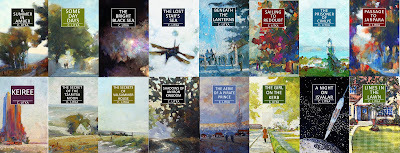
February 10, 2024
The Saturday Morning Post (No. 34)

Today's book is another book mentioned in that blog post of James Harris' in which he describes several books as "science fiction". Not as the type of book we think of when we hear "science fiction", but as a book of fiction that concerns itself with science. And like the first book from that post I read, The Signature of All Things by Elizabeth Gilbert, it is a story about about science, the times, the role of women in the world, and the world's expectations for them. And once again it is about a woman who defies those expectations.
My reviewer criteria. I like light, entertaining novels. I like smaller scale stories rather than epics. I like character focused novels featuring pleasant characters, with a minimum number of unpleasant ones. I greatly value clever and witty writing. I like first person, or close third person narratives. I dislike a lot of "head jumping" between POVs and flashbacks. I want a story, not a puzzle. While I am not opposed to violence, I dislike gore for the sake of gore. I find long and elaborate fight, action, and battle sequences tedious. Plot holes and things that happen for the convenience of the author annoy me. And I fear I'm a born critic in that I don't mind pointing out what I don't like in a story. However, I lay no claim to be the final arbitrator of style and taste, you need to decide for yourself what you like or dislike in a book.
Your opinions are always welcome. Comment below.
My Last 2023 Read
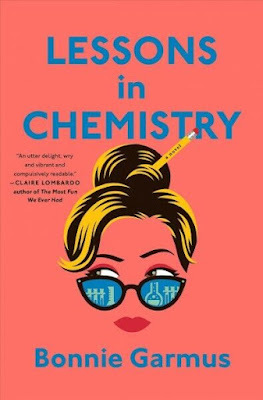
Lessons in Chemistry by Bonnie Garmus A
This is a very popular book. When I placed a hold on The Signature of All Things at the library, I also intended to place a hold on this book. However, I found that between my place in the line and the number of copies the library owned, I'd be waiting like a year for it, so I didn't bother. However, unknown to me, my wife had placed a hold on it as well some time earlier, and it became available in December. When she mentioned how much she liked the book she was reading I was delighted to discover that it was Lessons in Chemistry and that the library loan was long enough for me to read it as well. So on to the book.
This story is largely set in the early to mid 1950's. The hero of the story is one Elizabeth Zott, a brilliant scientist, and, as it turns out, a brilliant teacher. She was very unfairly denied the opportunity to earn her PhD in chemistry, and as a result, was forced to settle for a much more menial position in a scientific research company; not, however, comfortably so. She knew that she was more brilliant than all but one of the company's employees, but that fact would never be acknowledged simply because she was a woman - a woman who doesn't fit the accepted pattern of womanhood in the society of the era. This was not fair and she fought against that attitude. That is the theme of this book, and it doesn't shy away from saying so, just like its main character, Elizabeth Zott.
As usual, I don't really want to go into the details of the plot, on the off chance that you haven't read this book yet. Suffice to say that the story concerns her finding an oddball, but perfect mate, a failed-at-bomb-detecting, but brilliant dog, and the unconventional raising her extremely brilliant daughter. She finds a way to use her knowledge of chemistry to make a difference in the world in a very different way with her all her chemistry knowledge, along with an attitude. Not in the way she envisioned it, perhaps, but in a wider and more impactful way than just making discoveries in a lab. While the story has many touches of humor, the message is serious and clear; women have the same rights as men to live the life they want to live, and pursue the career they find most rewarding.
February 7, 2024
The 2024 Novel Cover Reveal
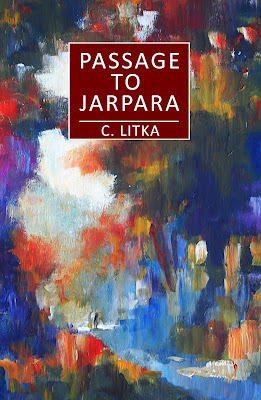
I am happy to announce that Passage to Jarpara, the third and final volume of the Tales of the Tropic Sea series is my 2024 novel. Since this is a cover reveal, we'll talk about the cover with only the blurb to describe the story at the end.
About the time I was writing Sailing to Redoubt, I painted half a dozen very impressionistic paintings of the island of Lil Lon, and the harbor of Fey Lon. The goal was to try to make them bright and tropical, without being too concerned about exact details. I used a section from one of the harbor paintings for the first edition, which can still be seen on Goodreads. I've changed the cover several times since then. The last, and present cover uses a painting entitled, Sunrise on Lil Lon. Being lazy, and knowing how iffy my painting is these days, I decided to use its companion piece, Sunset on Lil Lon for this book. I also decided to use the same color for the spine and print boxes as that book, to make the two a matching set (with middle book, The Prisoner of Cimlye, being an outlier). Both these paintings are impressionistic street scenes set on the little island of Lil Lon, but, as I mentioned, my main focus was on nice, bright colors - and lots of them. Do they work, as covers? Who knows? I'm not too concerned about whether covers draw readers or not. I don't think my readers care. Plus, I did have one reader/reviewer say that she was attracted to Sailing to Redoubt by the cover, so that's one win. The one thing I am concerned about is making my covers an expression of my "brand" hence their uniformity in design.
As for the current blurb, here's what I have;
Taef Lang is on a quest…
… To find a job.
Now a married man,the time has come for Taef to seek his long delayed career asa professor of Island archaeology and/or history. After introducing his new bride to his family, he andLessie, along with Sella and Carz set sail eastward across the TropicSea for the distant Island and University of Jarpara where he hopes to land his dream professorship.
Passage to Jarpara is a simple travelogue, an account of thatjourney across the Tropic Sea. It’s a record of islands calledon, old friends and acquaintance met, new ones made, as well as potential pirates, curse-beasts, haunted Tiki palaces, fire islands, and a race of immortals they encountered along the way. In short, it is another colorful glimpse of life in the Tropic Sea.
Passage to Jarparais the third and final volume of Tales of the Tropic Sea, drawing afitting conclusion to the adventures of Taef, Sella, and Lessie whichbegun with their voyage to Redoubt Island, and continued with thefreeing of the prisoner of Cimlye.
Stay tuned for more details!

February 3, 2024
The Saturday Morning Post (No. 33)

Time for another Cadfael Mystery
But before that, just a quick note on the paintings I use to identify a book review post as opposed to my regular blog post. I use these to paintings for my book reviews because two of my books are featured in the paintings. The book that appears in the painting above is When Patty Went to College by Jean Webster. Published March 1903. It was my Grandmothers which she had signed in her maiden name meaning that it has been in the family for well over a hundred years. The book featured in the other painting is A Princess of Mars, by Edgar Rice Burroughs, the Grosset & Dunlap October 1917 edition which makes it likely over a hundred years old as well. Time flies.
My reviewer criteria. I like light, entertaining novels. I like smaller scale stories rather than epics. I like character focused novels featuring pleasant characters, with a minimum number of unpleasant ones. I greatly value clever and witty writing. I like first person, or close third person narratives. I dislike a lot of "head jumping" between POVs and flashbacks. I want a story, not a puzzle. While I am not opposed to violence, I dislike gore for the sake of gore. I find long and elaborate fight, action, and battle sequences tedious. Plot holes and things that happen for the convenience of the author annoy me. And I fear I'm a born critic in that I don't mind pointing out what I don't like in a story. However, I lay no claim to be the final arbitrator of style and taste, you need to decide for yourself what you like or dislike in a book.
Your opinions are always welcome. Comment below.
A 2023 Read
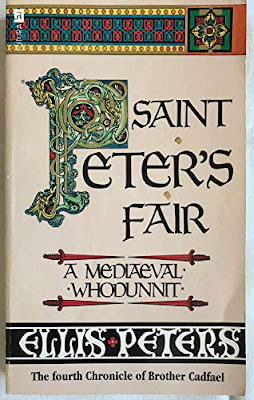
Saint Peter's Fair by Ellis Peters A
As I believe I have mentioned several times before, I am not a great fan of mysteries, in large part due to the fact that mystery writers seem to always create mysteries about murders. Whether this is due to the laziness of mystery writers or the demands of their audiences I can not say, but it generally annoys me. Especially when they toss in several more murders to cover up the first, as if that ever happens in real life. Or when every fourth person in the village is murdered every other month. All of which is to say that a murder mystery that earns a grade of A from me, must be special. The Cadfael stories are special.
There are several factors that make them special, starting with the writing and the characters. She seem to bring the characters to life with her engaging writing. She gives the reader the wise and worldly monk Cadfael who plays the "detective" along with a number of young, personable, characters, often in trouble whom he helps. Second, is the setting - which includes a map, which is always a big plus for me - but more importantly, the historical setting, which is a turbulent time in England with two claimants, King Stephen and Empress Maud vying for the throne of England. Peters sets her story squarely within that historical era, each story jumping 3 or 4 months ahead over the course of 8 years. I want stories to take me somewhere else, and Peters' 12th century England does that with what seems to me to be authentic detail. They're a fantasy grounded in history. And finally, while there is in each book a murder, or two, or three, they involve events that arrive at the abbey in a turbulent time, and thus, they seem a natural element of the story and the times, not a motheaten convention.
This story involves the yearly fair of St Peter put on by the Abbey of St Peter and Saint Paul. Merchants, customers, and perhaps others, have arrived for the three day fair. The Shrewsbury merchants are unhappy because they must close their shops for the three days, losing business, and the city, worn ragged by the siege of the previous year needs money as well. The prior declines to change the terms of the charter, and a minor riot by the youth of the city results, which apparently leads to the murder of a merchant, for which one of the city lads involved in the incident is suspected of committing. Brother Cadfael, and his friend, the under sheriff believe him to be innocent,. They suspect that the murder was not a simple act of a thief. As in all the books there is element of a whodunit in the story, but with a focus on character and colorful storytelling.
January 31, 2024
January Writing Update
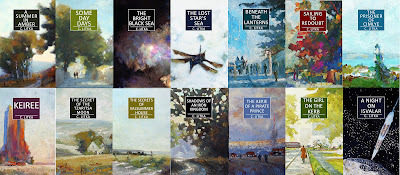
Today we have the January writing update that I had promised for last week. And just in the nick of time. I'm a mite superstitious, so I don't like announcing birds in the bush, no matter how close my hand is to them. But now, having put an hour's work on a novel nearly everyday since the first of October, I can announce that the bird is in hand. I am, as always, delighted to say that the first draft of my 2024 novel is complete.
While it is only the first draft, it represents a major milestone, since, for me, the first draft accounts for something like 85% of the work involved in the writing of a novel. Filling the empty white page with words is the hard part of writing. Once I have words on the page I can move along much faster. The second draft is all about punching up what I wrote, playing with the words I've written; adding a bit more description here and there, touching up the dialog. I don't usually edit out much. Instead I add the descriptive stuff that I wasn't thinking about when I was writing the scene. Thus my manuscript grows instead of shrinks as it "should" if you listen to the experts. I usually get a second draft done in a month or two. As for the third draft, I read the story on an ebook reader so as to get a feel as to how it reads in "real life", hopefully, only having to tweak a word or sentence here and there. With all that in mind, wind and tide permitting, I hope to release this book by the end of May at the latest.
You may have noticed that so far, I've not mentioned the work's title or what it's about and I don't intend to today. All the cool kid authors make "cover reveals" a big deal these days, and so I'll reveal my cover next week, along with a very brief blurb. Hey, I have this slot to fill each week, so I need to spread this out. But never fear, I always have a lot to say about my books, and I'll be talking more about it over the next month or two.
As for other news, only one of my books, The Secret of the Tzarista Moon has so far been made it as Apple audiobook. I think that I got the voice I wanted. However why that book, and why not more of them have made it into audiobooks? I have no idea. Hopefully I can make an announcement soon that they're all available.
So - drum roll - next week the cover of my 2024 novel and a bit of background on it! Stay turned.
January 27, 2024
The Saturday Morning Post (No. 32)

Yes, we have yet another fantasy book to review this week. I can explain. I put my name on the waiting list for the ebook version of this title probably 6 months ago with maybe 30 people ahead of me. I only received it in December 2023. I don't have any more books on the waiting list, so we'll read them as we find them going forward.
My reviewer criteria. I like light, entertaining novels. I like smaller scale stories rather than epics. I like character focused novels featuring pleasant characters, with a minimum number of unpleasant ones. I greatly value clever and witty writing. I like first person, or close third person narratives. I dislike a lot of "head jumping" between POVs and flashbacks. I want a story, not a puzzle. While I am not opposed to violence, I dislike gore for the sake of gore. I find long and elaborate fight, action, and battle sequences tedious. Plot holes and things that happen for the convenience of the author annoy me. And I fear I'm a born critic in that I don't mind pointing out what I don't like in a story. However, I lay no claim to be the final arbitrator of style and taste, you need to decide for yourself what you like or dislike in a book.
Your opinions are always welcome. Comment below.
Note: a 2023 Read
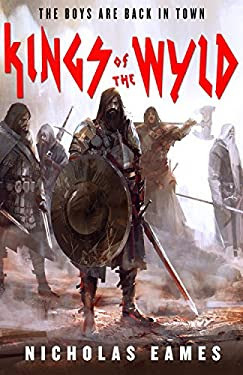
Kings of the Wyld by Nicholas Eames DNF 10%
Yet another fantasy book. What gives?
The elevator pitch for this book is that mercenary bands in this world are treaded like rock bands in ours. They have names, star members, and fans. The premise of the story is that we have this mercenary band whose members have been retired for more than a decade and most the most part, have settled down into ordinary lives. However, when the daughter of the former leader of the band, herself a mercenary, is trapped in a city under siege a thousand miles away, her father sets out to save her by seeking out the old band members to get back together again. To reach this besieged city, a thousand miles away, they have to cross the Heart Wyld forest, an place filled with all sorts of monsters and cross this wild woods and reach the distant city seemingly on foot - in time to reach a city besieged by a large army and do something to save her. Okaaaay....
As you can see from my grade above, the story didn't click with me. I found the premise to be sort of lame, and while the writing sort of snarky, and I found everything else struck me as off the shelf fantasy tropes. Perhaps the most off putting part of the story was the use of swear words. I have nothing against the words, bitch, shithole, fuck, bullshit, etc. Don't mind them at all. No, it's the fact that they are so ordinary, so commonplace, so much of a part of present day life, that they inevitably knock me out of the story and setting and take back into the pressroom break room or college dorm where such words were in common usage. If you are going to create an alternate world, don't be lazy. Invent your curses.
The use of commonplace curses and phrases was symptomatic of the commonplaceness of the prose and setting. Everything encountered in the first 10% of the story I read was nothing that I haven't encountered before. It was fine, but just a generic fantasy setting with generic fantasy characters. Only the premise was cute, though I doubt it really made sense. So, in the end, I found it hard to want to pick the book back up and continue reading. Life is too short, to spend time doing something you really don't want to do, if you don't have to. So DNF. But what do I know? I had to wait six months to read a five year old book, so don't take my word for it, if it sounds interesting to you go for it. It has one sequel, and another on the way.
January 24, 2024
A Glitch in the Matrix
 The Glitch with Static
The Glitch with StaticLast week I may have experienced a glitch in the matrix, at lease in the dream matrix. It went down for a moment.
By way of introduction I should mention that as an old man, I apparently don't need more than 4 or 5 hours of sound sleep a night, and as a consequence I often spend 3 to 5 hours either awake or dozing. I spent these hours thinking about whatever my current writing project is, which is usually boring enough to put me back to sleep. However, being on the borderland of sleep and wakefulness, dreams are sometimes half in sleep and half in (semi) wakefulness. And I was in this borderland one night last week when I experienced the momentary glitch of the matrix. Well, something glitched, anyway.
I was dreaming when suddenly, the "screen" in my dream abruptly, for no reason, when entirely white - with a hiss of static. All I "saw" in my head, in my dream, was whiteness, with a distinct hint of static. This white gap in the dream was so abrupt that it pushed me over the border to wakefulness. It only lasted a second or less before the dream continued on for a bit, but I was awake and consciously aware of it happening, and the strangeness of it happening. I can think of no explanation for it happening, except that something somewhere went "boink" for a second, either in my mind or the matrix. Of that I'm certain.
I'm not going to seriously propose that there is such a thing as the matrix, or that we are in some simulation, as some scientists propose, that might occasionally go momentarily down. And yet, I find the incident very strange, as I find my dreams. For, you see, my mind is not visual. I can't call up more than a murky approximation of an image in my mind; more like just the knowledge of what it looks like than an actual image. This syndrome is known as aphantasia. The strange thing is that I know that even though I can't recall my dreams in any more detail than the murky images my waking mind can produce, I know that I do see images in my dreams, complicated, full color ones, and my impression is that they can be quite detailed, including the faces of all those strangers I encounter in my dreams... I find this disconnect between my waking mind and my sleeping ones... interesting. And inexplicable. It seems to me that the disconnect between the waking world and the sleeping one for me, at least, is very hard to explain with our current knowledge. I have to believe that we know a lot less about what we think we know than what there is to know. Just say'n.
The writing update promised for today will appear next week, wind and tide permitting.
